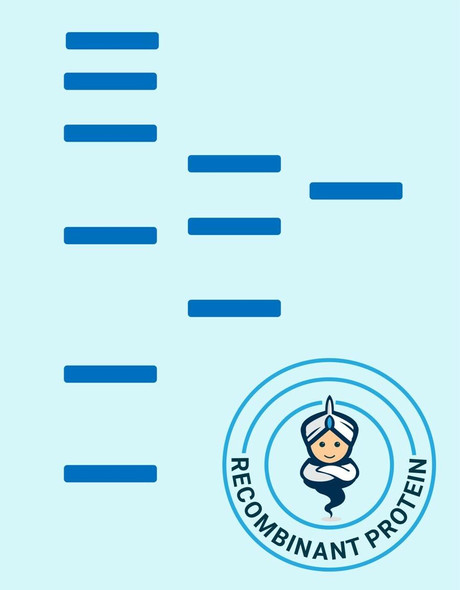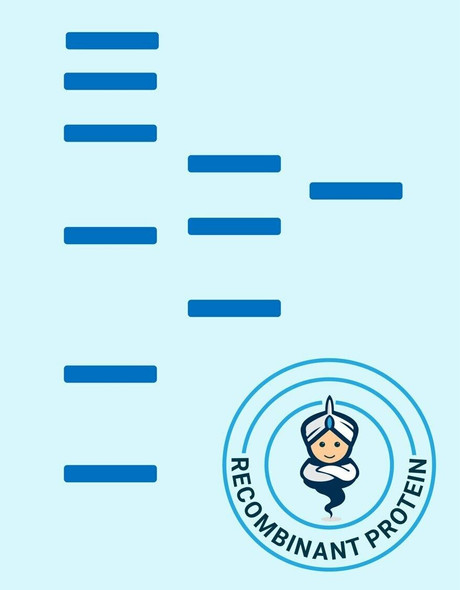Human IL 4 Recombinant Protein (RPPB0506)
- SKU:
- RPPB0506
- Product type:
- Recombinant Protein
- Size:
- 20ug
- Species:
- Human
- Target:
- IL 4
- Synonyms:
- BCGF
- BCDF
- B cell stimulating factor
- BSF-1
- Source:
- Escherichia Coli
- Uniprot:
- P05112
Description
| Product Name: | Human IL 4 Recombinant Protein |
| Product Code: | RPPB0506 |
| Size: | 10µg |
| Species: | Human |
| Target: | IL 4 |
| Synonyms: | BCGF, BCDF, B cell stimulating factor, BSF-1, Lymphocyte stimulatory factor 1, IL-4, MGC79402, Binetrakin, Pitrakinra. |
| Source: | Escherichia Coli |
| Physical Appearance: | Sterile Filtered clear solution. |
| Formulation: | Interleukin-4 His-Tag is supplied in 20mM Tris-HCl and10% glycerol. |
| Stability: | Store at 4°C if entire vial will be used within 2-4 weeks. Store, frozen at -20°C for longer periods of time.For long term storage it is recommended to add a carrier protein (0.1% HSA or BSA).Please avoid freeze thaw cycles. |
| Purity: | Greater than 95.0% as determined by SDS-PAGE. |
| Amino Acid Sequence: | MGSSHHHHHH SSGLVPRGSH MHKCDITLQE IIKTLNSLTE QKTLCTELTV TDIFAASKNT TEKETFCRAA TVLRQFYSHH EKDTRCLGAT AQQFHRHKQL IRFLKRLDRN LWGLAGLNSC PVKEANQSTL ENFLERLKTI MREKYSKCSS |
| Biological Activity: | The ED50 for this effect is <0.5ng/ml. Measured in a cell proliferation assay using TF1 human erythroleukemic cells. |
Interleukin-4 is a pleiotropic cytokine produced primarily by activated T lymphocytes, basophils and mast cells. Multiple immune response-modulating functions are performed by IL-4 on a variety of cell types and it has an important role in the regulator of isotype switching, induction of IgE production in B lymphocytes and differentiation of precursor T helper cells. IL-4 binds to both membrane-bound and secreted soluble IL-4 receptors.
Interleukin-4 Human Recombinant produced in E.Coli is single, a non-glycosylated, Polypeptide chain containing 150 amino acids fragment (25-153) and having a total molecular mass of 17.2kDa.The IL-4 is fused to a 20 amino acid His-Tag at N-terminus and purified by proprietary chromatographic techniques.
| UniProt Protein Function: | IL4: Participates in at least several B-cell activation processes as well as of other cell types. It is a costimulator of DNA-synthesis. It induces the expression of class II MHC molecules on resting B-cells. It enhances both secretion and cell surface expression of IgE and IgG1. It also regulates the expression of the low affinity Fc receptor for IgE (CD23) on both lymphocytes and monocytes. Genetic variations in IL4 may be a cause of susceptibility to ischemic stroke (ISCHSTR); also known as cerebrovascular accident or cerebral infarction. A stroke is an acute neurologic event leading to death of neural tissue of the brain and resulting in loss of motor, sensory and/or cognitive function. Ischemic strokes, resulting from vascular occlusion, is considered to be a highly complex disease consisting of a group of heterogeneous disorders with multiple genetic and environmental risk factors. Belongs to the IL-4/IL-13 family. 2 isoforms of the human protein are produced by alternative splicing. |
| UniProt Protein Details: | Protein type:Cell cycle regulation; Cytokine; Motility/polarity/chemotaxis; Secreted; Secreted, signal peptide Chromosomal Location of Human Ortholog: 5q31.1 Cellular Component: extracellular space; external side of plasma membrane Molecular Function:protein binding; growth factor activity; cytokine activity; interleukin-4 receptor binding Biological Process: regulation of isotype switching; positive regulation of isotype switching to IgG isotypes; negative regulation of osteoclast differentiation; positive regulation of transcription, DNA-dependent; microglial cell activation; regulation of proton transport; female pregnancy; positive regulation of activated T cell proliferation; chemotaxis; response to organic cyclic substance; positive regulation of isotype switching to IgE isotypes; positive regulation of interleukin-10 production; B cell costimulation; connective tissue growth factor biosynthetic process; positive regulation of MHC class II biosynthetic process; positive regulation of B cell proliferation; positive regulation of T cell proliferation; positive regulation of interleukin-13 production; negative regulation of macrophage activation; response to nutrient; response to drug; cholesterol metabolic process; regulation of immune response; negative regulation of chronic inflammatory response; T-helper 2 type immune response; regulation of phosphorylation; B cell activation; negative regulation of nitric oxide biosynthetic process; negative regulation of acute inflammatory response; defense response to protozoan; T-helper 1 cell lineage commitment; response to ethanol; positive regulation of chemokine biosynthetic process; positive regulation of tyrosine phosphorylation of Stat5 protein; positive regulation of T cell differentiation; innate immune response in mucosa; retina development in camera-type eye; B cell differentiation; response to cytokine stimulus; cellular defense response; immune response; positive regulation of transcription from RNA polymerase II promoter; positive regulation of transcription factor activity; T-helper 2 cell differentiation; negative regulation of transcription, DNA-dependent; positive regulation of defense response to virus by host; negative regulation of apoptosis Disease: Stroke, Ischemic |
| NCBI Summary: | The protein encoded by this gene is a pleiotropic cytokine produced by activated T cells. This cytokine is a ligand for interleukin 4 receptor. The interleukin 4 receptor also binds to IL13, which may contribute to many overlapping functions of this cytokine and IL13. STAT6, a signal transducer and activator of transcription, has been shown to play a central role in mediating the immune regulatory signal of this cytokine. This gene, IL3, IL5, IL13, and CSF2 form a cytokine gene cluster on chromosome 5q, with this gene particularly close to IL13. This gene, IL13 and IL5 are found to be regulated coordinately by several long-range regulatory elements in an over 120 kilobase range on the chromosome. Two alternatively spliced transcript variants of this gene encoding distinct isoforms have been reported. [provided by RefSeq, Jul 2008] |
| UniProt Code: | P05112 |
| NCBI GenInfo Identifier: | 124337 |
| NCBI Gene ID: | 3565 |
| NCBI Accession: | P05112.1 |
| UniProt Secondary Accession: | P05112,Q14630, Q6NZ77, |
| UniProt Related Accession: | P05112 |
| Molecular Weight: | 15,797 Da |
| NCBI Full Name: | Interleukin-4 |
| NCBI Synonym Full Names: | interleukin 4 |
| NCBI Official Symbol: | IL4 |
| NCBI Official Synonym Symbols: | BSF1; IL-4; BCGF1; BSF-1; BCGF-1 |
| NCBI Protein Information: | interleukin-4; binetrakin; pitrakinra; B cell growth factor 1; interleukin 4 variant 2; B_cell stimulatory factor 1; lymphocyte stimulatory factor 1 |
| UniProt Protein Name: | Interleukin-4 |
| UniProt Synonym Protein Names: | B-cell stimulatory factor 1; BSF-1; Binetrakin; Lymphocyte stimulatory factor 1; Pitrakinra |
| Protein Family: | Interleukin |
| UniProt Gene Name: | IL4 |
| UniProt Entry Name: | IL4_HUMAN |










